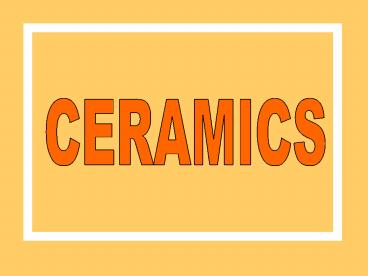A1258149828TCqFv - PowerPoint PPT Presentation
1 / 21
Title:
A1258149828TCqFv
Description:
Alumina (Al2O3) Silica (SiO2) Refractories: Furnace linings. Heat ... Special refractories (Zirconia, magnesia, alumina) Used as electrical resistance ... – PowerPoint PPT presentation
Number of Views:319
Avg rating:3.0/5.0
Title: A1258149828TCqFv
1
CERAMICS
2
Ceramics are compounds between metallic and
nonmetallic elements which can be oxides,
nitrides, and carbides. The wide range of
materials that falls within this classification
includes ceramics that are composed of clay
minerals, cement and glass. Up until past 40 or
so years, the most important materials in this
class were termed the traditional ceramics,
those for which the primary raw material is clay.
Products that are considered to be traditional
ceramics are china, porcelain, bricks, tiles and
in addition, glasses and high-temperature
ceramics.
3
Over the years, significant progress has been
made in understanding the fundamental character
of ceramics and of the phenomena that occur in
them that are responsible for their unique
properties. Consequently, a new generation of
these materials has evolved, and the term
ceramic has taken on much broader meaning.
These new materials have a rather dramatic effect
on our lives electronics, computer,
communication, aerospace and a host of other
industries rely on their use.
4
Since the atomic bonding in ceramic materials is
either partially or totally ionic, most ceramic
crystal structures may be thought of as being
composed of electrically charged ions instead of
atoms. The metallic ions are positively charged
cations and the nonmetallic ions are negatively
charged anions. Ceramics are composed of at least
two elements and their crystal structures are far
more complex than those of metals
5
Na
Cl -
Unit Cell for the rock salt (NaCl) structure
6
Examples for Ceramic Materials
- Alumina
- Boron Carbide
- Chromium Carbide
- Graphite
- Magnesia
- Silicon Carbide
- Tungsten Carbide
- Zirconia
- Clay
- Brick
- Limestone
- Granite
7
Properties of Ceramic Materials
- Crystalline and noncrystalline states
- High melting temperatures (varying from 3500 to
7000 o F) - All ceramics are brittle at room temperatures
- Very low resistance to tensile loads. Very low
fracture strengths. Microcracks are formed very
easily under tensile stresses. - Stronger under compressive loads and microcracks
are not formed as easily as in tension.
8
Properties of Ceramic Materials (Contd)
- High hardness nd good wear resistance.
- High toughness
- Low thermal and electrical conductivity.
- High creep resistance at elevated temperatures
- Capacity to remain unreactive and inert when
exposed to severe environments - Can be magnetized and demagnetized, some can be
permanently magnetized
9
At room temperature ceramics almost always
fracture before any plastic deformation can occur
in response to an applied tensile load. The
measure of ceramic materials ability to resist
fracture when a crack is present is specified in
terms of fracture toughness. Table 1 shows a
comparison between the toughness of ceramics and
other materials.
10
Material
Table 1
11
Stress-Strain Behavior of Ceramics
Instead of standard tensile test which is applied
to metals, a transverse bending test (three-or
four-point loading) is employed. In this test a
rod specimen having either a circular or a
rectangular cross section is bent until fracture.
LOAD (F)
SUPPORT
L/2
L/2
12
Stress-Strain Behavior of Ceramics
The maximum stress, or stress at fracture is
known as the Modulus of Rupture (?mr), which is
an important mechanical parameter for ceramics.
Modulus of rupture is given by the following
equations
CIRCULAR
RECTANGULAR
d
2R
b
13
Table 2. Characteristic modulus of rupture and
elastic modulus values for various ceramic
materials.
14
40,000 30,000 20,000 10,000
ALUMINUM OXIDE
STRESS (Psi)
GLASS
0.0002 0.0004 0.0006 0.0008 STRAIN
15
(Classification based on application)
16
- Glasses
- Containers
- Windows
- Lenses
- Fiberglass
- Most commercial glasses are combination of silica
soda limestone
17
- Clay Products
- Structural products
(Bricks, tiles, sewer pipes) - Whitewares
(Porcelain, pottery, tableware, china, plumbing
fixtures) - These products are composed of
- Alumina (Al2O3) Silica (SiO2)
18
- Refractories
- Furnace linings
- Heat treatment equipment
- Power generation equipment
- Types of refractories
- Fireclay
- Silica
- Basic (Open hearth furnaces)
- Special refractories (Zirconia, magnesia,
alumina) Used as electrical resistance elements,
cruicible materials, internal furnace components.
19
- Abresives
- Grinding wheels
- Polishing wheels
- Lapping wheels
- Types of abrasives
- Diamond
- Silicon carbide
- Aluminum carbide
- Aluminum oxide
- Tungsten carbide
20
- Other Applications
- Soft magnets
- Hard magnets
- Electrical insulators
- Semiconductor
- Internal combustion engine blocks
- Valves
- Rotors
- Electronic packaging (Boron nitride, aluminum
nitride, silicon carbide) - Composite materials (matrix or fiber)
21
Back to Table of Contents































